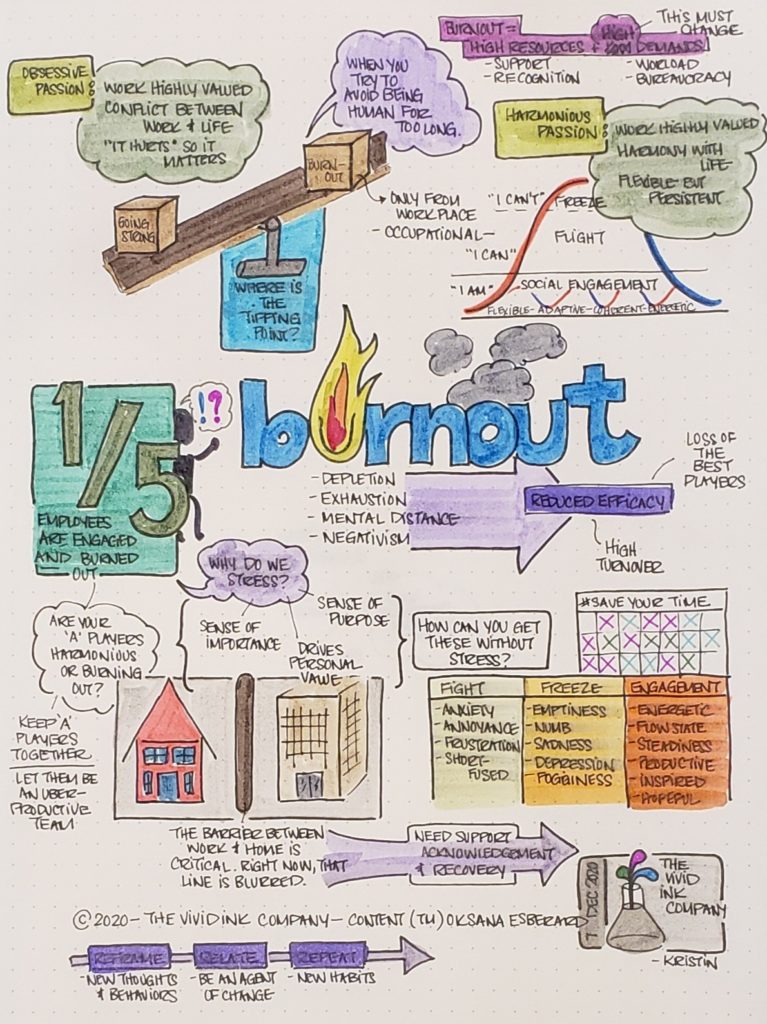Recently, Petra Coach presented a webinar, “Going Strong or Burning Out?” with Oksana Esberard.
If you’re a business leader, this information is crucial to sharpening your skills and growing as a leader and team member.
You can find the full recording here.
The below Illustrated Model is from The Vivid Ink Company. Kristin McLane and her team transform the spoken word into lasting and actionable works of art. Check them out on Facebook, LinkedIn, Instagram or their website.
To augment the recording, we noted takeaways and tips from the presentation.
Also check out Oksana’s Upcoming Events and SattvaMe Solutions for yourself and your organization.
Top Takeaways
“Burnout is what happens when you try to avoid being human for too long.” – Michael Gungor
What is Burnout?
Burnout is a syndrome conceptualized as resulting from chronic workplace stress that has not been successfully managed.
It is characterized by:
- Feelings of energy depletion or exhaustion
- Increased mental distance from one’s job, or feelings of negativism or cynicism related to one’s job
- Reduced professional efficacy
This is considered in occupational context and should not be applied to experiences in other areas of life.
- Ask yourself, how many times have you felt burnout in your career?
Those who are highly engaged in their work are more likely to have burnout, not necessarily people who just “clock in and clock out.” Just because someone is productive does not mean they aren’t at risk.
Burnout is like sitting in the worst traffic jam with a catastrophe on the road.
- Ask yourself, why do we keep putting ourselves in stressful situations?
Stress can be an addiction:
- People want to make sure they are good enough and want to feel valuable
- It can give you the sense of feeling significant and important
- There’s a sense of guilt and fear of not doing enough
As long as stress is satisfying those needs, you will not get rid of that behavior. Start flipping how you are satisfying your needs in order to get rid of that behavior.
Emotions
Passion. Energy. Strength.
Two Types of Passion:
Obsessive Passion:
- Work is highly valued, but brings uncontrollable urge to work
- Creates conflict between work and other life activities
- Persist when it’s risky to do so
- Large part of self-concept due to unstable ego
- Rigid persistence
- Result in Burnout
Harmonious Passion:
- Work is highly valued, and brings intrinsic joy
- Accompanied by sense of control
- In harmony with other life activities
- Positively contributes to work satisfaction and well-being
- Flexible persistence
- Knowing when to disengage
- Prevents burnout
Ask yourself, reflect back on when you’ve had burnout, what is the underlying reason for those feelings? Were you attempting to prove something or were you truly engaged in your work and getting satisfaction?
Think about what emotions you feel before you get burnt out – What are you feeling?
Burnout Signals – Emotions & Feelings
Fight – Anxiety, projecting forward, annoyance, resentment, frustration, irritation, headache
Freeze – Emptiness, numb, sadness, depression, fogginess, cannot concentrate
Engagement – Energetic, flow state, steadiness, productive, inspired, hopeful
Burnout Markers
If you are feeling like this every day, you may be burnt out:
- Are you regularly physically and emotionally exhausted?
- Do you feel lack of energy? How often?
- Feel sad or hopeless?
- You no longer feel joy from things that used to bring you joy at work.
- You feel less connected with people than you once did.
- How are you viewing your colleagues?
- Do you feel like you are not contributing anything to your job?
What is the Cause?
- Heavy workloads
- Job insecurity
- Frustrating work routines:
- Too many meetings
- Far too little time for creative work
- Crunch the downtime that is necessary for restoration
Burnout = High Resources + High Demands
High Resources:
- Supervisor support
- Rewards and recognition
- Self-efficacy and work
Low Demands:
- Low workload
- Low cumbersome bureaucracy
- Low to moderate demands on concentration and attention
What’s Needed?
- Employee support/high resources
- Acknowledgement/feel good about work
- Opportunities for recovery from stress
- Mental and emotional well-being
Re-Evaluate
- Zero-base meeting calendar
- Team up the A-Players
- Culture around “precious time” and wellness
Like what you see? Register for our upcoming workshops & webinars today!








